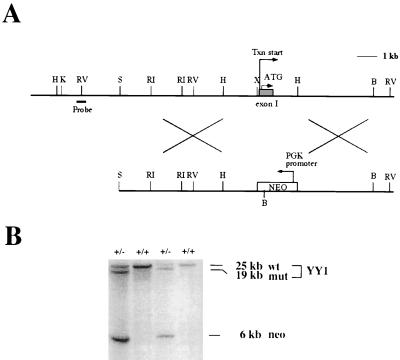FIG. 1.
Generation of a targeted mutation at the mouse YY1 locus and identification of the YY1 mutant allele. (A) Genomic organization of the mouse YY1 locus and design of the targeting construct. An 18-kb YY1 fragment was obtained from a genomic library of the mouse strain 129/Sv. The YY1 fragment targeted for gene replacement contains exon I and the sequences 11 kb 5′ and 6 kb 3′ to exon I. A XhoI/HindIII fragment (approximately 2 kb) containing the entire exon I including both the transcription and the translational start sites was replaced with the neo cassette. The arrow marked “Txn start” denotes the transcriptional start site. The arrow labeled “ATG” denotes the translational start site. The probe used in Southern hybridization to detect homologous recombination is indicated by a thick bar and labeled as such. The size of a 1-kb sequence is also indicated. B, BamHI; H, HindIII; K, KpnI; RV, EcoRV; S, SacI; X, XhoI; RI, EcoRI; PGK, phosphoglycerate kinase. (B) Identification of ES cells containing a mutant YY1 allele. The YY1 targeting vector was introduced into ES cells and selected with G418. Southern blot hybridization was performed on genomic DNA extracted from ES cells, digested with BamHI, and hybridized to a radioactively labeled neo and external YY1 probe as shown in panel A. Wild-type (wt) ES cells contain a single 25-kb YY1 fragment, while YY1+/− ES cells contain the 25-kb and the mutant (mut) 19-kb YY1 fragment. The 6-kb fragment containing the neo gene is detected for the YY1+/− ES cells only. The genotypes of the ES cells are indicated above the lanes. The size of the hybridized bands is indicated on the right.

